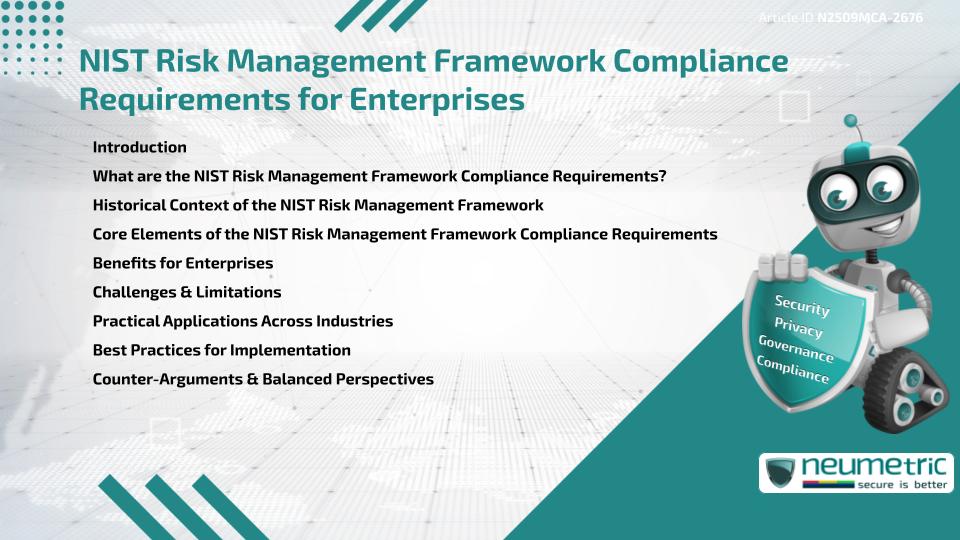Table of Contents
ToggleIntroduction
The NIST Risk Management Framework Compliance Requirements provide enterprises with a structured approach to managing Risks while ensuring Regulatory alignment. These requirements help Organisations implement consistent processes to safeguard information systems, protect Sensitive Data & meet Compliance obligations. By applying this Framework, enterprises can better manage Threats while demonstrating Accountability to Stakeholders & Regulators.
What are the NIST Risk Management Framework Compliance Requirements?
The NIST Risk Management Framework Compliance Requirements outline a step-by-step process for identifying, assessing & managing Risks in information systems. They integrate Security & Privacy requirements into an organisation’s lifecycle, ensuring that Compliance is not an afterthought but an inherent part of operations. Enterprises can use these requirements to establish strong Governance structures while reducing Vulnerabilities.
Historical Context of the NIST Risk Management Framework
The NIST Risk Management Framework [RMF] originated as part of the broader NIST 800-series publications. Initially aimed at federal agencies, it was designed to standardise security practices across Government systems. Over time, the Framework expanded to private industries as Organisations recognised its value in creating structured, repeatable & auditable processes for Risk Management & Compliance.
Core Elements of the NIST Risk Management Framework Compliance Requirements
- Categorise information systems based on impact.
- Select baseline Security Controls.
- Implement chosen controls within organisational systems.
- Assess the effectiveness of implemented Controls.
- Authorise system operations after evaluating Risks.
- Monitor systems continuously to ensure Compliance & Resilience.
Benefits for Enterprises
Following the NIST Risk Management Framework Compliance Requirements helps enterprises:
- Standardise Risk Management practices across systems.
- Improve Compliance with federal & industry-specific regulations.
- Enhance decision-making through structured oversight.
- Increase transparency with Auditors & Stakeholders.
- Build Resilience by integrating Security throughout the system lifecycle.
Challenges & Limitations
Implementing the Framework can be resource-intensive, requiring specialised expertise & time. Smaller enterprises may find it challenging to keep up with the Framework’s complexity. Additionally, strict adherence can create rigid processes that may not adapt well to rapidly changing environments or emerging Threats.
Practical Applications Across Industries
- Healthcare: Supporting HIPAA Compliance while protecting Patient Data.
- Finance: Meeting Regulatory requirements for safeguarding Customer Information.
- Government: Ensuring standardised security across federal systems.
- Education: Protecting student & research data with structured processes.
- Technology: Building secure Cloud environments & managing Intellectual Property.
Best Practices for Implementation
- Conduct a thorough Gap Analysis before applying the Framework.
- Train leadership & staff to understand their Compliance responsibilities.
- Map Framework steps to existing organisational Policies.
- Use automation for Monitoring & Reporting to reduce manual effort.
- Regularly update practices to reflect new Risks & Regulatory changes.
Counter-Arguments & Balanced Perspectives
Critics argue that the NIST Risk Management Framework Compliance Requirements may create a Compliance-heavy culture rather than a proactive Risk-based approach. Others caution that focusing too rigidly on the Framework can limit flexibility. However, supporters emphasise that the RMF provides a solid foundation that enterprises can adapt to their unique environments, blending Compliance with practical Risk Management.
Takeaways
- Provides structured steps for enterprise Risk Management.
- Enhances Regulatory alignment across industries.
- Improves Decision-making & Stakeholder Trust.
- Strengthens Resilience with Continuous Monitoring.
- Requires balancing flexibility with structured Compliance.
FAQ
What are the NIST Risk Management Framework Compliance Requirements?
They are structured steps for identifying, assessing & managing Risks in information systems while ensuring Compliance.
Why are these requirements important for enterprises?
They standardise processes, improve Compliance & enhance Security Resilience across organisational systems.
Who uses the Framework?
Federal agencies, private enterprises & regulated industries widely adopt the Framework to ensure Security & Compliance.
What challenges do enterprises face when implementing it?
Challenges include complexity, resource needs & maintaining flexibility in dynamic environments.
Does it cover all Cybersecurity Risks?
It addresses a broad set of Risks but should be combined with Organisation-specific Security Measures.
How does it support Audits & Oversight?
It provides structured documentation & reporting, making Audits more transparent & efficient.
Need help for Security, Privacy, Governance & VAPT?
Neumetric provides organisations the necessary help to achieve their Cybersecurity, Compliance, Governance, Privacy, Certifications & Pentesting needs.
Organisations & Businesses, specifically those which provide SaaS & AI Solutions in the Fintech, BFSI & other regulated sectors, usually need a Cybersecurity Partner for meeting & maintaining the ongoing Security & Privacy needs & requirements of their Enterprise Clients & Privacy conscious Customers.
SOC 2, ISO 27001, ISO 42001, NIST, HIPAA, HECVAT, EU GDPR are some of the Frameworks that are served by Fusion – a SaaS, multimodular, multitenant, centralised, automated, Cybersecurity & Compliance Management system.
Neumetric also provides Expert Services for technical security which covers VAPT for Web Applications, APIs, iOS & Android Mobile Apps, Security Testing for AWS & other Cloud Environments & Cloud Infrastructure & other similar scopes.
Reach out to us by Email or filling out the Contact Form…


